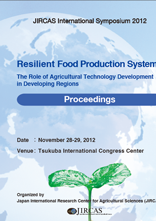Resilience of Social-Ecological Systems for Food Security

Resilience is defined as “the capacity of a system to experience shocks while retaining essentially the
same function, structure, feedbacks, and therefore identity (Walker et al. 2004)”. Although resilience has
been defined and analyzed as ecological as well as social-ecological terms, their integration is still under
development. Recently, the concept of resilience has been directly applied to regional development and
food security issues where people heavily rely their livelihoods on natural resource base. Also, academic
communities consider that resilience and adaptive capacity of social-ecological system is an important
component for achieving sustainability.
Within the Semi-Arid Tropical Sub-Saharan Africa, communities’ livelihoods depend critically on
fragile and poorly endowed natural resources, and poverty and environmental degradation are widespread.
People in these regions depend largely on rain-fed agriculture, and their livelihoods are vulnerable to
environmental variability. Environmental resources such as vegetation and soil are also vulnerable to
human activities. To surmount these environmental challenges, human society and ecosystems must be
resilient to (recover quickly from) environmental shocks. In other words, resilience of social-ecological
system (SES) is considered an important component for achieving sustainability.
“Vulnerability and Resilience of Social-Ecological Systems” (RIHN Resilience Project) has proposed
qualitative and quantitative approaches to empirically analyze resilience of rural households in Zambia.
We argued that in order to operationalize resilience, it is important for us to consider resilience in the
context of food security, more broadly human security, of rural households in SAT region. We conducted
an integrated study for analyzing farmers’ coping strategy against climatic shocks in Southern Zambia.
We collected various intensive household level data including on-farm precipitation, agricultural
production, off-farm production, consumption, and anthropometric measures as a proxy for nutritional
status for three cropping seasons from 2007 to 2010. The objective of this research is to identify ways in
which the resilience to environmental variability of subsistence farmers in the SAT can be strengthened.
The rainfall pattern varied across rainy seasons and farmers were facing not only annual variation but
also seasonal variation of precipitation. The December 2007 heavy rain (473 mm/week) caused significant
damages to agricultural production and infrastructure such as roads and bridges in the region. Farmers
responded quickly by replanting maize and shifting to other crops. The field experiment suggested that
maize yield was strongly influenced by topography and temperature. Thus cultivation under different
topographic contexts partly mitigated climatic shocks.
Resilience at the household level was quantitatively measured and factors affecting resilience were
identified. A sharp decline in food consumption before harvest was observed after heavy rain in December
2007. After March 2008, food consumption gradually recovered, however the speed of recovery was very
slow. Heavy rainfall in 2007 resulted in a sharp increase in maize prices in February 2009 affecting the
ability of households to purchase food during the lean period. It took more than one year for most
households to recover food consumption to the level before December 2007 heavy rainfall. The recovery
speed was high in lowland due to personal gift, public food aid and non-agricultural income. Cattle
holdings helped household recovery in upper terrace. Some new activities for getting cash income, such
as livestock sales, fishery and wage labor emerged to offset a shortfall of income. Flexibility in employing
diverse strategies to successfully cope with climatic shocks is a suggestive of household resilience.
Resilience in SAT context can be defined as the short-run recovery of food consumption, food
production and livelihoods. In the long-run, resilience is the adaptive capacity of household, community
and region to absorb shocks, adapt to change and to learn, innovate and transform. Rural households and
communities in Africa are facing not only risks from natural disasters but also risks from social and
economic changes, such as international price hikes of cash crops. Various assets including agricultural technology, livestock and land holdings and cash income opportunities/abilities are considered as crucial
for the recovery of households and communities. Diversified access to resource use help households to
recover from shock quickly including information via mobile phone use. The availability and the access
to ecological services that supply wild food during the lean period are also important for consumption
smoothing.
Strengthening social safety net in different levels is necessary to increase adaptive capacity. Especially
female headed households had less resilience compared to male headed households due to poor access to
food and agricultural technologies. Development of infrastructure that enable households to access market
for crop sales and food purchase, as well as for stabilizing food prices in the region is also important.
Comprehensive approaches and long-run observations are necessary to understand complex responses and
feed backs due to environmental and socio-economic factors affecting rural households. For enhancing
adaptive capacity of individuals and households, long-term strategies are required to improve basic
services such as education, medical services, public road and transport. In the long-run, not only is
increasing specific resilience against climatic change and/or disaster risks but also increasing general
resilience of the society required to prepare for uncertainty. More comprehensive approach to food security
is required under the increasing environmental variability.
| Date of issued | |
|---|---|
| Creator | Chieko Umetsu |
| Publisher | Japan International Research Center for Agricultural Sciences |
| Available Online | |
| Issue | 2012 |
| spage | 27 |
| epage | 42 |
| Rights | Japan International Research Center for Agricultural Sciences |
| Language | eng |
